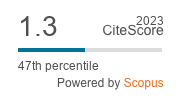Competitiveness as the Ability to Adjust: the EU–10 Exports Structure and Its Convergence to the German Pattern
DOI:
https://doi.org/10.2478/cer-2018-0007Keywords:
catching‑up economy, exports specialization convergence, macro competitiveness, EU–10Abstract
Competitiveness of a nation is associated with a set of characteristics that enable structural adjustment to global technological trends, and as a consequence, a rise in the living standard of its citizens. For catching-up economies, GDP convergence towards the most developed economies, constituting their developmental goal, relies upon its ability to shift production and exports structure towards specialization based on knowledge and innovation. Thus, in this paper, competitiveness is evaluated through structural adjustments of exports, and for catching-up economies (the EU–10 states) it may be understood as the ability to close the structural gap to the most developed countries (here: the strongest EU member economy: Germany). We analyse the evolution of the EU–10 nations’ exports specialization in the years 2000 and 2014, checking whether the convergence towards the German exports pattern can be observed, and which of the analysed economies shows the best ability to shift its exports structure towards high-tech specialization. We look additionally at exports structures in 2004 (the year of EU-accession of eight out of 10 countries in the sample) and in 2009 (world trade collapse during the economic crisis). The analysis is based on the Revealed Comparative Advantage (RCA) concept by Balassa (1965). We use the UN Trade Statistics data in the Standard International Trade Classification (SITC), Rev. 4. Commodity groups are classified following the methodology developed by Wysokińska (1997, p. 18).Downloads
References
Abramowitz M. (1986), Catching Up, Forging Ahead, and Falling Behind, ‘The Journal of Economic History’, 46(2), 385–406. doi: 10.1017/S0022050700046209
Google Scholar
Balassa B. (1965), Trade Liberalisation and ‘Revealed’ Comparative Advantage. The Manchester School, 33(2), 99–123. doi.org doi: 10.1111/j.1467-9957.1965.tb00050.x
Google Scholar
Bieńkowski W., Weresa M., Czajkowski Z., Gomułka M., Brocka-Palacz B., Latoszek E., Misala J. (Eds.). (2008). Czynniki i miary międzynarodowej konkurencyjności konkurencyjności gospodarek w kontekście globalizacji – wstępne wyniki badań (Vol. 284). Szkoła Główna Handlowa.
Google Scholar
Castellacci F. (2008). Innovation and the competitiveness of industries: Comparing the mainstream and the evolutionary approaches, ‘Technological Forecasting and Social Change’, 75(7), 984–1006. doi.org doi: 10.1016/j.techfore.2007.09.002
Google Scholar
Cho D.S., & Moon H.C. (2008). From Adam Smith to Michael Porter: evolution of competitiveness theory (Reprinted). New Jersey: World Scientific.
Google Scholar
Cohen S.S., & Zysman J. (1988). Manufacturing Innovation and American Industrial Competitiveness, ‘Science’, 239(4844), 1110–1115.
Google Scholar
Czarny E., & Śledziewska K. (2012). Międzynarodowa współpraca gospodarcza w warunkach kryzysu. Wnioski dla Polski. Warszawa: PWE Polskie Wydawnictwo Ekonomiczne.
Google Scholar
Ezalea-Harrison. (2005), On the Competing Notion of International Competitiveness, ‘Advances in Competitiveness Research’, 13(1), 80–87.
Google Scholar
Lollar J.G., Beheshti H.M. & Whitlow B.J. (2010). The role of integrative technology in competitiveness, ‘Competitiveness Review’, 20(5), 423–433. doi.org 10595421011080797
Google Scholar
Lonska J., & Boronenko V. (2015), Rethinking Competitiveness and Human Development in Global Comparative Researches, ‘Procedia Economics and Finance’, 23, 1030–1036. doi.org)00475-X
Google Scholar
Martin R. (2005). A Study on the Factors of Regional Competitiveness. Final Report for the Euoropean Commission.
Google Scholar
Peretto P. (1990). Technology, learning opportunity and international competitiveness: some empirical evidence with panel data, ‘Giornale Degli Economisti E Annali Di Economia’, 219–244.
Google Scholar
Porter M.E. (1985). Competitive Advantage. New York: The Free Press.
Google Scholar
Porter M.E. (1990). What Is National Competitiveness?, ‘Harvard Business Review’, 68(2), 84–85.
Google Scholar
Reinert E. (1995). Competitiveness and its predecessors – a 500-year cross-national perspective, ‘Structural Change and Economic Dynamics’, 6, 23–42.
Google Scholar
Wysokińska Z. (1997). Aspekty technologiczne konkurencyjności międzynarodowej Unii Europejskiej oraz Polski, ‘Studia Europejskie’, (2).
Google Scholar
Żmuda M. (2017), Taxonomy of International Competitiveness, ‘Journal of Management and Business Administration. Central Europe’, 25(3), 97–116.
Google Scholar
Żmuda M., Czarny E. (2017), Competitiveness of a catching-up economy as ability to close technological gap: Evolution of the EU–10 exports specialization towards the German pattern, ‘CBS Working Paper’, (4), https://cbs.de/en/wp-content/uploads/sites/3/2018/02/Working-Paper–2017-No.–4-Catching-Up-Economy-to-close-technoclogical-gap-Zmuda-Czarny.pdf
Google Scholar
Downloads
Published
How to Cite
Issue
Section
License

This work is licensed under a Creative Commons Attribution-NonCommercial-NoDerivatives 4.0 International License.











